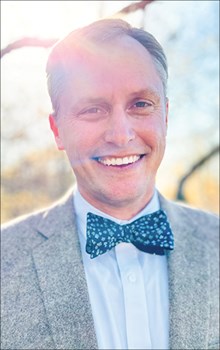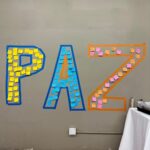In A Different Mirror, Ronald Takaki writes about the landing of the English Pilgrims to what we now think of as New England in the early 1600s. Upon reaching the continent’s shores, the new arrivals found the Indigenous Americans were being decimated by viruses like smallpox, diseases that arrived with the Europeans and from which the Native Americans had no immunities. These epidemics were so sweeping that agricultural land that had been tended to by Native peoples had been abandoned.
The English settlers interpreted both the diseases they introduced and the seemingly vacant land as God’s provision. Takaki writes that “John Winthrop declared that the decimation of Indians by smallpox manifested a Puritan destiny: God was ‘making room’ for the settlers and ‘hath hereby cleared our title to this place’” (Ronald Takaki, A Different Mirror [New York: Back Bay Books, 2008], 40).
But disease didn’t clear all the Indigenous inhabitants, so the settlers needed to justify their claims of ownership over the places to which they had so recently arrived. This they found by observing how Indigenous communities treated the land. Winthrop, a founder and second governor of the Boston Colony, annulled the claims Native people made on the land because they had not subdued it in a manner recognized by the Europeans. Unable or unwilling to appreciate Indigenous agrarianism, the settlers labeled Native people as lazy and unproductive and thus unworthy stewards of the land that they then took for themselves.
What was it that allowed the European settlers to see these unfamiliar lands as uninhabited? What influences warped their vision so they would not recognize Indigenous people as fully human, as capable caretakers of their lands? Instead of encountering this new world as caretakers, many quickly came to understand both the land and its inhabitants as sources of wealth waiting to be plundered.
The inheritors of this distorted vision live in a world in which both people and places have been refashioned around this central lie. No longer do we live as gracious recipients of God’s good gifts expressed throughout creation. The evidence of our changed posture is everywhere to be seen.
So thoroughly have humans altered the world that scientists wonder if we have entered a new era, the Anthropocene, in which humans have thoroughly impacted the world’s climate and ecosystems for generations to come. That the impacts of this new epoch are not experienced equally can be seen in the incredible species loss we are living through. It can also be seen in which people suffer the worst of the environmental crisis. The fact that air pollution, toxic waste, and other forms of environmental abuse disproportionately affect people of color makes the connection between racism and environmental injustice undeniable.
Those of us insulated by the relative safety of status and class are prone to miss the ways humans have been made vulnerable by the environmental crisis. In a peer-reviewed study, the Environmental Protection Agency demonstrated the disproportionate effect of climate change on vulnerable populations. For example, African Americans are 34 percent more likely to live in regions with the highest increases in childhood asthma and 40 percent more likely to live where temperature-related deaths are projected to grow as global warming increases (Environmental Protection Agency, Climate Change and Social Vulnerability in the United States: A Focus on Six Impacts, www.epa.gov/cira/social-vulnerability-report).
The United Nations has found that vulnerability to climate change “is higher in locations with poverty, governance challenges and limited access to basic services and resources, violent conflict and high levels of climate-sensitive livelihoods (e.g., smallholder farmers, pastoralists, fishing communities)” (Climate Change 2022: Impacts, Adaptation and Vulnerability. Contribution of Working Group II to the Sixth Assessment Report of the Intergovernmental Panel on Climate Change, [New York: Cambridge University Press, 2022], 3‑33, doi:10.1017/9781009325844.001).
I don’t have to look around the world or even across the country to find examples of the intersection between environmental and human vulnerabilities. From our apartment, we can walk twenty minutes to Promontory Point, a grassy, tree-covered spit of land that extends into Lake Michigan and provides gorgeous views of the lake and the city’s skyline to the north. But turn your gaze southward and the scene changes. From the limestone boulders at the lake’s edge, if the weather is clear, I can see smoke pouring from the stacks at the steel mills in Gary, Indiana, which line the southern rim of the lake.
While Indiana is over 80 percent white, Gary is more than 80 percent African American. The Black and Latino/a community is also overrepresented in the surrounding region when compared with the rest of the state. These demographic anomalies take on a sobering quality when we learn that heavy industry in the area, like the steel mills visible from my pleasant lakeshore vantage point, release nearly 700,000 metric tons of carbon dioxide into the air and expose residents of Gary to the eighth highest cancer risk in the United States (Shannon Knudtson. “Environmental Racism in Lake County, IN,” ArcGIS StoryMaps, December 5, 2022, https://storymaps.arcgis.com/stories/9480d33e369748f28a447f5c13da82f0).
Environmental racism refers to how sources of pollution are often situated in communities of color. In the same way that certain places are more susceptible to pollution, certain communities are more vulnerable to harm. But it’s not just the vulnerabilities shared by specific places and communities of color that reveal the bond between environmental damage and racism. We need only to remember God’s vision in which all of creation is dependent on and related to one another. Creation’s relationship with itself is one through which love is given and received. In this vision, humans live as caretaking priests whose presence offers the creation in worship to its Creator and blesses the creation with its Creator’s love.
Though we have become accustomed to the ungodly assumptions that consign some places and people to scattering and splintering harm, God’s creational intent wakes us up to the intertwining relationships that are meant to hold all things and people together so that everything and everyone might flourish. It is the harmony for which we were created, more than anything else, which ought to elicit our curious concern when we notice that some people and places have been excluded from the Creator’s gifts.
Adapted from Plundered by David W. Swanson. ©2024 by David W. Swanson. Used by permission of
InterVarsity Press. www.ivpress.com.

About David W. Swanson
David W. Swanson is the pastor of New Community Covenant Church, a multicultural congregation in Chicago’s Bronzeville neighborhood. He helps lead New Community Outreach, a nonprofit that collaborates with the community to reduce sources of trauma, and he speaks around the country on the topics of racial justice and reconciliation. He is the author of Rediscipling the White Church, and he has written articles for Christianity Today, the Englewood Review of Books, and the Covenant Companion. He lives in Chicago with his wife and two sons.



